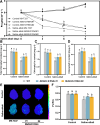Engineering saline-alkali-tolerant apple rootstock by knocking down MdGH3 genes in M9-T337
- PMID: 40549263
- PMCID: PMC12185813
- DOI: 10.1007/s44154-025-00236-7
Engineering saline-alkali-tolerant apple rootstock by knocking down MdGH3 genes in M9-T337
Abstract
Soil salinization and alkalization have become an increasingly severe global issues, significantly limiting both the yield and quality of apples (Malus × domestica). M9-T337 is a widely used apple dwarfing rootstock; however, it is sensitive to saline-alkali stress. Therefore, developing saline-alkali tolerant apple rootstocks is essential. In this study, we utilized RNAi (RNA interference) technology to knock down GH3 genes in the M9-T337 background, aiming to engineer a dwarfing and stress-tolerant apple rootstock. We found that MdGH3 RNAi plants exhibited superior morphology compared to M9-T337 under saline-alkali stress conditions, characterized by more robust root systems, increased plant height, a lower Na+/K+ ratio, and enhanced photosynthetic and antioxidant capacities. Moreover, when MdGH3 RNAi plants were used as rootstocks, the GL-3/MdGH3 RNAi plants also displayed greater plant height, root vitality, photosynthetic ability, and antioxidant capacity compared to GL-3 grafted onto M9-T337 rootstock. Taken together, our study constructed a saline-alkali-tolerant apple rootstock by knocking down MdGH3 genes.
Keywords: MdGH3 RNAi; Apple; M9-T337; Rootstock; Saline-alkali stress.
© 2025. The Author(s).
Conflict of interest statement
Declarations. Ethics approval and consent to participate: All authors consent to participate. Consent for publication: All authors consent for publication. Competing interests: Q.G. is a member of the editorial board but was not involved in the journal's review, or any decisions, related to this submission.
Figures







Similar articles
-
Engineering drought-tolerant apple by knocking down six GH3 genes and potential application of transgenic apple as a rootstock.Hortic Res. 2022 May 26;9:uhac122. doi: 10.1093/hr/uhac122. eCollection 2022. Hortic Res. 2022. PMID: 35937857 Free PMC article.
-
Engineering saline-alkali-tolerant apple rootstocks by overexpressing MdHYL1 in M9-T337.Mol Breed. 2025 Jun 25;45(7):58. doi: 10.1007/s11032-025-01579-9. eCollection 2025 Jul. Mol Breed. 2025. PMID: 40583866
-
Nano-Zinc Oxide Can Enhance the Tolerance of Apple Rootstock M9-T337 Seedlings to Saline Alkali Stress by Initiating a Variety of Physiological and Biochemical Pathways.Plants (Basel). 2025 Jan 15;14(2):233. doi: 10.3390/plants14020233. Plants (Basel). 2025. PMID: 39861585 Free PMC article.
-
Systemic pharmacological treatments for chronic plaque psoriasis: a network meta-analysis.Cochrane Database Syst Rev. 2017 Dec 22;12(12):CD011535. doi: 10.1002/14651858.CD011535.pub2. Cochrane Database Syst Rev. 2017. Update in: Cochrane Database Syst Rev. 2020 Jan 9;1:CD011535. doi: 10.1002/14651858.CD011535.pub3. PMID: 29271481 Free PMC article. Updated.
-
Ear drops for the removal of ear wax.Cochrane Database Syst Rev. 2018 Jul 25;7(7):CD012171. doi: 10.1002/14651858.CD012171.pub2. Cochrane Database Syst Rev. 2018. PMID: 30043448 Free PMC article.
References
-
- Chang S, Puryear J, Cairney J (1993) A simple and efficient method for isolating RNA from pine trees. Plant Mol Biol Report 11(2):113–116. 10.1007/BF02670468
-
- Chen C, He G, Li J, Perez-Hormaeche J, Becker T, Luo M, Wallrad L, Gao J, Li J, Pardo JM, Kudla J, and Guo Y (2023) A salt stress-activated GSO1-SOS2-SOS1 module protects the Arabidopsis root stem cell niche by enhancing sodium ion extrusion. EMBO J 42(13):e113004. 10.15252/embj.2022113004 - PMC - PubMed
-
- Cimen B, Yesiloglu T (2016) Rootstock breeding for abiotic stress tolerance in citrus. In: Abiotic and biotic stress in plants - recent advances and future perspectives. IntechOpen. 10.5772/62047
-
- Cuartero J, Bolarín MC, Asíns MJ, Moreno V (2006) Increasing salt tolerance in the tomato. J Exp Bot 57:1045–1058. 10.1093/jxb/erj102 - PubMed
Grants and funding
LinkOut - more resources
Full Text Sources

